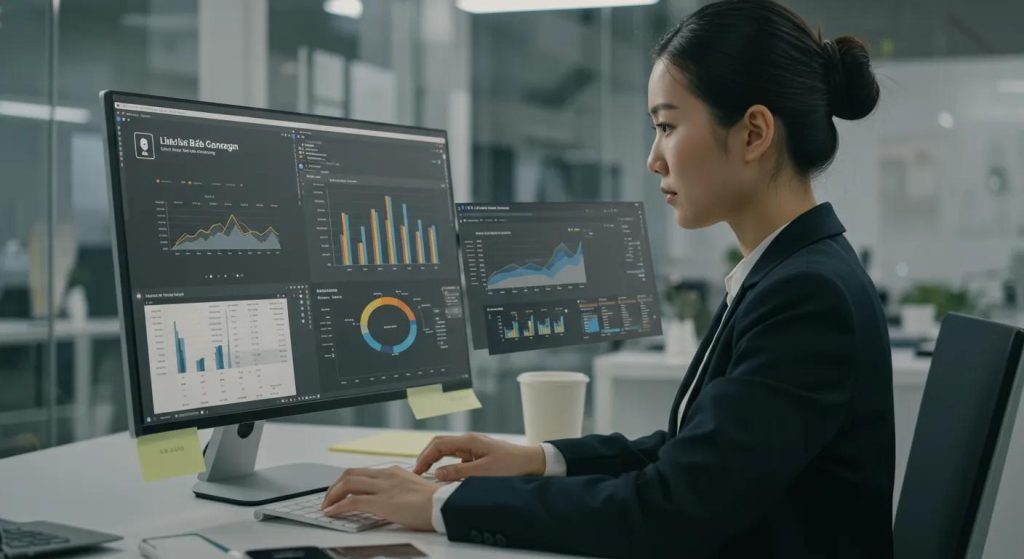Boost B2B Growth with a LinkedIn Ad Agency in Sydney
How a LinkedIn Ad Agency in Sydney Drives B2B Growth for Your Business
LinkedIn advertising is a targeted paid media channel that connects Sydney B2B companies with decision-makers using professional signals such as job title, company size, and industry. This guide explains how a specialist LinkedIn ad agency in Sydney can turn platform targeting and ad formats into measurable pipeline growth, higher-quality leads, and more predictable sales conversations. You will learn why LinkedIn outperforms other social media channels for B2B intent, which ad formats map to common objectives, and how a data-driven process reduces investment per lead while increasing conversion quality. We also cover practical service offerings an agency provides, realistic Australian investment considerations, and the analytics and AI tools used for continuous optimisation. After reading, you will have a clear action plan for running LinkedIn campaigns locally, understand how to evaluate agencies, and know when to deploy Account-Based Marketing (ABM) or Lead Gen Forms to accelerate B2B growth in Sydney.
Why Is LinkedIn Essential for B2B Growth in Sydney?
LinkedIn is essential for B2B growth because it aggregates professional intent and corporate attributes that predict purchase authority and relevance. The platform enables targeting by seniority, function, and company attributes, which reduces wasted impressions and improves the likelihood of meaningful sales conversations. For Sydney businesses, that means better alignment between ad audience and in-market buyers, faster qualification, and higher conversion rates than generic social channels. The next subsections unpack audience quality, local market reach, and the most effective ad formats for B2B objectives.
LinkedIn offers distinct advantages for B2B marketers in Sydney:
- Decision-maker concentration: Access to senior roles and purchasing influencers in one platform.
- Precision targeting: Industry, function, and company-size filters reduce noise and ad waste.
- Higher purchase intent: Professional context improves lead relevance and conversion probability.
These benefits translate into measurable pipeline improvements when campaigns combine targeting precision with relevant creative, which we explore next.
What Makes LinkedIn the Top Platform for B2B Lead Generation?

LinkedIn’s audience skews toward professionals who influence purchasing decisions, making it the top platform for B2B lead generation. Targeting options let advertisers combine seniority, job function, and company size to isolate buyers rather than casual users, which reduces wasted spend and shortens sales cycles. Compared with broad social networks, LinkedIn yields higher-quality leads because the profile metadata acts as a proxy for budget and authority. Understanding this audience quality is the foundation for campaign strategy and guides creative that speaks directly to buyer needs.
The quality of targeting on LinkedIn leads directly into how Sydney businesses can exploit localised reach and event-driven campaigns, which we cover next.
How Does LinkedIn’s Sydney Market Reach Benefit Local B2B Businesses?
LinkedIn’s professional graph includes large numbers of Australian professionals concentrated in metropolitan hubs like Sydney, enabling geographically focused ABM and event promotion. Local reach allows marketers to run city-specific campaigns for conferences, workshops, and regional product launches while still targeting decision-makers by role. That local precision supports both demand generation and in-market conversion tactics for Sydney sales teams. Leveraging city-level and industry-specific lists helps convert awareness into meetings and pipeline more efficiently.
Local targeting naturally informs ad format selection, which is the next critical decision for campaign design and performance.
Which LinkedIn Ad Formats Are Most Effective for B2B Marketing?
LinkedIn supports multiple ad formats that map to distinct B2B goals: awareness, engagement, lead capture, and direct outreach. Choosing the right format aligns creative with funnel stage — for example, video for thought leadership versus Message Ads for immediate demo bookings. Mix ad types across the funnel to nurture prospects and reduce friction in lead capture. Below is a practical format-to-objective mapping.
The following list explains format-to-objective uses for quick selection:
- Sponsored Content: Thought leadership and top-of-funnel engagement to drive website visits and form fills.
- LinkedIn Message Ads (InMail): Direct outreach to book demos and meetings with named prospects.
- Lead Gen Forms: Low-friction capture for gated content and demo requests; integrates with CRMs.
- Video & Carousel Ads: Engagement and storytelling to increase brand recall and product understanding.
These format choices feed into how an agency packages LinkedIn advertising services, which we describe next.
What LinkedIn Advertising Services Does a Sydney Agency Offer for B2B Growth?
A Sydney LinkedIn ad agency typically bundles audience strategy, creative development, campaign setup, ongoing optimisation, and analytics reporting to deliver consistent lead flow. Agencies combine ABM list management with Lead Gen Forms, creative testing, and CRM integration to move prospects from awareness to pipeline. Services also include multi-touch sequences, sales enablement for follow-up, and transparent reporting that ties campaigns to pipeline metrics. The following subsections break down lead generation mechanics, ABM workflows, and the value of personalised service.
Agencies commonly provide this set of LinkedIn services:
- Lead generation campaign management: Setup, targeting, forms, and CRM routing for qualification.
- Account-Based Marketing (ABM): Targeted outreach to named accounts with personalised creative.
- Creative & asset production: Copy, imagery, video, and carousel design optimised for professional audiences.
These service capabilities are best compared across ad formats and expected KPIs, shown in the table below.
Intro to ad-format comparison: This table helps match LinkedIn ad formats to common B2B goals and measurable KPIs.
| Ad Format | Best use | Typical KPI |
|---|---|---|
| Sponsored Content | Thought leadership, content distribution | CTR, Time on site, Leads |
| Message Ads (InMail) | Direct outreach to named roles | Meeting bookings, Response rate |
| Lead Gen Forms | Fast lead capture with pre-filled fields | CPL, Form completion rate |
| Video Ads | Product demonstrations and storytelling | View rate, Engagement |
| Carousel Ads | Multi-point value propositions | Engagement, Clicks |
This comparison shows that format choice affects both investment and conversion expectations, guiding campaign design and budget allocation.
How Do Lead Generation Campaigns on LinkedIn Work?
Lead generation campaigns begin with audience definition, creative that matches buyer pain points, and a friction-minimising capture method such as Lead Gen Forms or a landing page. Campaigns then route captured leads into CRM systems for immediate sales follow-up and automated nurturing sequences to qualify prospects. Continuous A/B testing of creative and audience segments optimises for lower cost per lead and higher conversion rates. Effective lead flows combine fast routing with a qualification layer to ensure sales teams receive high-value opportunities.
Understanding lead capture mechanics flows naturally into the ABM use case on LinkedIn, which we describe next.
What Is Account-Based Marketing on LinkedIn?

Account-Based Marketing on LinkedIn targets a curated list of high-value companies and decision-makers with personalised creative and sequencing across ad formats. The ABM workflow typically includes list building, matched-audience upload, personalised creative, and multi-touch sequencing to influence multiple stakeholders within a target account. Measurement focuses on account engagement metrics and pipeline influence rather than individual lead counts. ABM is particularly effective for complex B2B sales where deal size and stakeholder alignment justify targeted spend.
ABM success hinges on personalised execution and a responsive optimisation cadence, which is enhanced by boutique service models described below.
How Does Personalised Service Enhance LinkedIn Ad Performance?
Personalised service from a boutique agency accelerates iteration, aligns messaging to niche Sydney markets, and increases accountability through dedicated managers. A close client-agency relationship enables faster creative pivots, tailored audience refinements, and campaign adjustments based on immediate sales feedback. This hands-on approach improves optimisation speed and often yields better CPL and pipeline outcomes than one-size-fits-all account structures. Clear reporting and frequent strategy reviews keep LinkedIn campaigns aligned with business goals.
Personalised account management leads into the data-driven processes that drive measurable outcomes, explored in the next H2.
Intro to process mapping: The table below shows how agency processes connect targeting, tools, and outcomes for measurable results.
| Process Phase | Tool | Expected Outcome |
|---|---|---|
| Audience Research | Sales Navigator / LinkedIn lists | High-relevance target segments |
| Creative Testing | A/B creative variants | Improved CTR and conversion |
| Lead Routing | CRM integration | Faster sales follow-up |
| Optimisation | AI bid tools & analytics | Lower CPL, higher ROI |
How Does a Data-Driven LinkedIn Ad Strategy Drive Strong B2B Results?
A data-driven LinkedIn strategy is designed to deliver measurable results by systematically reducing uncertainty through research, targeting, testing, and automated optimisation. The approach starts with audience segmentation, follows with hypothesis-driven creative tests, and uses analytics and AI to reallocate budgets toward high-performing segments. Regular reporting ties campaign activity to pipeline metrics so teams can evaluate ROI and scale winners. Below, a concise numbered process outlines the steps agencies use to deliver measurable growth.
Agencies typically use this stepwise optimisation approach:
- Research: Identify buyer personas and create targeted segments.
- Targeting: Build matched audiences and refine by role and company attributes.
- Creative & Testing: Run A/B tests to find high-converting messaging and assets.
- Optimise: Use AI-assisted bidding and weekly tweaks to scale effective variants.
This numbered framework demonstrates how each phase feeds the next and maintains accountability through measurable KPIs.
What Role Does Precise Targeting Play in B2B LinkedIn Ads?
Precise targeting is the primary lever for improving efficiency in B2B LinkedIn campaigns because it filters impressions to likely buyers, reducing wasted spend and improving conversion relevance. Combining seniority, function, and company size yields tighter cohorts that respond better to B2B offers. Narrower targeting typically increases CPC but lowers CPL by improving lead quality. Effective targeting strategies integrate CRM insights and Sales Navigator data to mirror real-world buyer profiles and improve downstream conversion.
Targeting decisions naturally lead to AI and automation options that accelerate optimisation, which we cover next.
How Are AI Tools Integrated to Optimise LinkedIn Campaigns?
AI tools accelerate campaign optimisation through predictive creative testing, bid automation, and audience discovery that surfaces high-potential segments. Machine learning models can predict which creative variants will perform and automate bid allocations to maximise conversions within budget constraints. Human oversight remains essential to align automation with brand voice and business rules. Combining AI with weekly human-led reviews produces faster, evidence-backed improvements without sacrificing strategic control.
Automation and AI integration then inform the full campaign lifecycle, described in the next subsection.
What Is the Process from Campaign Setup to Continuous Optimisation?
Campaign lifecycles follow a predictable sequence: discovery, setup, launch, test, scale, and report, with specific timelines for each phase to manage expectations. Discovery defines audiences and KPIs, setup configures Campaign Manager and creative, launch uses test budgets, testing validates hypotheses, scaling amplifies winners, and reporting ties activity to pipeline outcomes. Typical cadences include daily monitoring, weekly optimisation, and monthly strategy reviews. Transparent timelines and KPI tracking ensure agencies can demonstrate progress and adjust to market feedback.
The process mapping above complements investment guidance, which is the next practical consideration for Sydney advertisers.
Intro to investment discussion: The table below compares common LinkedIn investment metrics in Australia and optimisation levers to reduce them.
| Investment Metric | General Expectation (Australia) | Notes |
|---|---|---|
| CPC (Investment per Click) | Varies, typically competitive | Influenced by industry and targeting specificity |
| CPL (Investment per Lead) | Varies based on ad format and lead quality | Reflects the value of the lead |
| CPM (Investment per Mille) | Varies, higher for narrow, senior audiences | Reflects reach to specific professional groups |
What Are Typical LinkedIn Ad Investment Considerations and How Can Sydney Businesses Maximise ROI?
LinkedIn ad investment levels in Australia vary widely based on industry, targeting granularity, and ad format, with investment per click (CPC) and investment per lead (CPL) reflecting the value of reaching decision-makers. To maximise ROI, businesses should prioritise targeting that matches buying authority, use Lead Gen Forms to reduce friction, and test creative quickly to lower CPL. Budget frameworks that start with test allocations and scale winning combinations produce better long-term efficiency. In the following subsections, we provide practical insights and explain how a boutique agency approach can improve return on ad spend.
Here are three optimisation tactics for better ROI:
- Start with test budgets: Run small experiments to find high-performing audiences before scaling.
- Prioritise lead quality: Use stronger qualification flows to improve sales conversion rates.
- Iterate creative fast: Frequent A/B tests reduce CPL as the best variants are identified.
These tactics are consistent with what boutique growth agencies implement when managing LinkedIn spend.
What Is the Average Investment Per Click and Investment Per Lead in Australia?
Investment per click (CPC) on LinkedIn in Australia varies depending on competition and audience specificity, while investment per lead (CPL) is influenced by lead quality and the chosen ad format. Narrow, senior-level targeting may increase CPC but tends to deliver higher-value leads, which often justifies the investment. Ad format influences investment as well: Message Ads and Lead Gen Forms can be more impactful per action and yield higher conversion relevance. Starting with a controlled test budget and assessing CPL against downstream pipeline contribution clarifies whether spend is delivering ROI.
Understanding these ranges leads into how a specific agency approach tackles optimisation, which we discuss next.
How Does Results Agency Ensure Optimal Return on LinkedIn Ad Spend?
Results Agency positions itself as a boutique growth agency in Sydney that combines personalised service with a data-driven approach to optimise LinkedIn ad spend and improve ROI. Their model emphasises precise targeting, iterative creative testing, and transparent reporting that ties ads to pipeline outcomes, enabling clients to see how CPL translates to revenue influence. By blending hands-on account management with performance analytics, the agency focuses on accountability and measurable improvements rather than generic activity. Readers interested in bespoke ROI modelling are invited to request tailored analysis and case studies directly from Results Agency to understand expected outcomes for their sector.
This example of agency approach sets the stage for real-world outcomes, which we examine next through a case-study framework.
Intro to case-study structure: The table below outlines a framework for presenting LinkedIn campaign case studies and the metrics to expect.
| Case Element | Purpose | Key Metrics |
|---|---|---|
| Challenge | Define client problem | Pain points, target accounts |
| Strategy | Tactics used | Formats, targeting, creative |
| Execution | Implementation details | Budgets, cadence, integrations |
| Outcome | Impact measurement | CPL, qualified leads, pipeline value |
How Have Sydney B2B Businesses Achieved Growth with LinkedIn Ads?
Sydney B2B businesses achieve growth with LinkedIn ads by aligning campaigns to sales processes, using ABM for high-value accounts, and focusing on lead quality over volume. Successful programs integrate LinkedIn leads with CRM workflows and sales outreach to convert contacts into meetings and opportunities. Case studies are most persuasive when they show time-bound pipeline influence and longitudinal metrics that connect leads to revenue. Below we outline how to interpret case studies and invite readers to request verified client examples for deeper validation.
Readers should look for these three elements in any LinkedIn case study:
- Clear baseline and challenge: How the client’s situation was measured before campaigns.
- Tactics mapped to outcomes: Which formats and targeting drove the results.
- Pipeline & revenue linkage: Evidence that leads influenced actual sales and deal value.
These elements help buyers distinguish one-off performance from sustainable growth demonstrated across months.
What Are Some Measurable Success Stories from LinkedIn Ad Campaigns?
When evaluating success stories, focus on the structure: a defined challenge, a clear strategy, campaign execution details, and measurable outcomes such as improved CPL, increased qualified leads, or pipeline contribution. Many agencies present sample templates that show percentage improvements, but demand verified metrics that include timeframe and attribution method. Requesting these specifics helps set realistic expectations and clarifies whether results were driven by paid media or complementary channels.
Examining case templates and methodology leads to assessing claims like “strong results,” which is the focus next.
How Do Case Studies Demonstrate Strong Results and Long-Term Growth?
Case studies demonstrate a credible approach to achieving strong results when they include longitudinal tracking, clear attribution methods, and repeatable processes that other clients can adopt. Buyers should look for evidence that improved lead quality translated into sustained pipeline growth over multiple months, not just short-term spikes. Reliable studies show how ongoing optimisation reduced CPL while increasing conversion rates and pipeline value. Agencies that pair personalised service with transparent metrics make it easier for businesses to assess whether expected outcomes are realistic for their market.
By using this evidence-based assessment approach, Sydney B2B marketers can select LinkedIn strategies and partners that deliver measurable, long-term growth.




